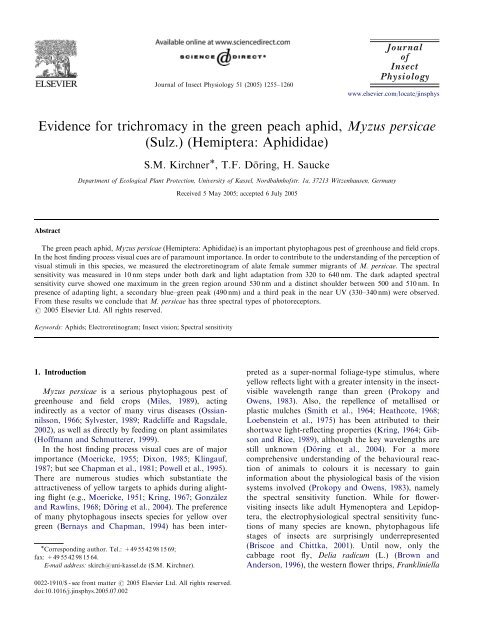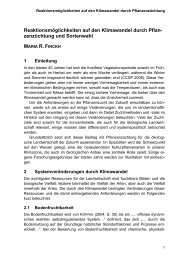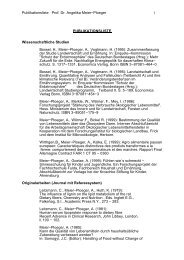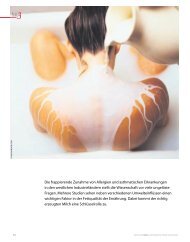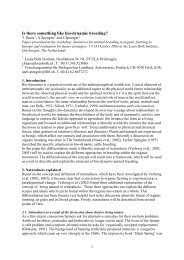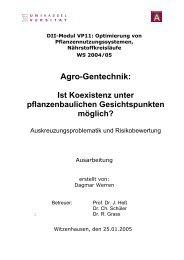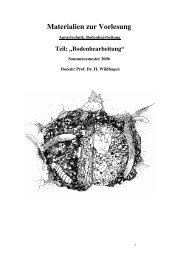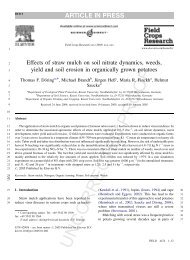Evidence for trichromacy in the green peach aphid, Myzus persicae ...
Evidence for trichromacy in the green peach aphid, Myzus persicae ...
Evidence for trichromacy in the green peach aphid, Myzus persicae ...
Create successful ePaper yourself
Turn your PDF publications into a flip-book with our unique Google optimized e-Paper software.
Journal of Insect Physiology 51 (2005) 1255–1260<br />
<strong>Evidence</strong> <strong>for</strong> <strong>trichromacy</strong> <strong>in</strong> <strong>the</strong> <strong>green</strong> <strong>peach</strong> <strong>aphid</strong>, <strong>Myzus</strong> <strong>persicae</strong><br />
(Sulz.) (Hemiptera: Aphididae)<br />
Abstract<br />
S.M. Kirchner ,T.F. Do¨ r<strong>in</strong>g,H. Saucke<br />
Department of Ecological Plant Protection, University of Kassel, Nordbahnhofstr. 1a, 37213 Witzenhausen, Germany<br />
Received 5 May 2005; accepted 6 July 2005<br />
The <strong>green</strong> <strong>peach</strong> <strong>aphid</strong>, <strong>Myzus</strong> <strong>persicae</strong> (Hemiptera: Aphididae) is an important phytophagous pest of <strong>green</strong>house and field crops.<br />
In <strong>the</strong> host f<strong>in</strong>d<strong>in</strong>g process visual cues are of paramount importance. In order to contribute to <strong>the</strong> understand<strong>in</strong>g of <strong>the</strong> perception of<br />
visual stimuli <strong>in</strong> this species,we measured <strong>the</strong> electroret<strong>in</strong>ogram of alate female summer migrants of M. <strong>persicae</strong>. The spectral<br />
sensitivity was measured <strong>in</strong> 10 nm steps under both dark and light adaptation from 320 to 640 nm. The dark adapted spectral<br />
sensitivity curve showed one maximum <strong>in</strong> <strong>the</strong> <strong>green</strong> region around 530 nm and a dist<strong>in</strong>ct shoulder between 500 and 510 nm. In<br />
presence of adapt<strong>in</strong>g light,a secondary blue–<strong>green</strong> peak (490 nm) and a third peak <strong>in</strong> <strong>the</strong> near UV (330–340 nm) were observed.<br />
From <strong>the</strong>se results we conclude that M. <strong>persicae</strong> has three spectral types of photoreceptors.<br />
r 2005 Elsevier Ltd. All rights reserved.<br />
Keywords: Aphids; Electroret<strong>in</strong>ogram; Insect vision; Spectral sensitivity<br />
1. Introduction<br />
<strong>Myzus</strong> <strong>persicae</strong> is a serious phytophagous pest of<br />
<strong>green</strong>house and field crops (Miles,1989),act<strong>in</strong>g<br />
<strong>in</strong>directly as a vector of many virus diseases (Ossiannilsson,1966;<br />
Sylvester,1989; Radcliffe and Ragsdale,<br />
2002),as well as directly by feed<strong>in</strong>g on plant assimilates<br />
(Hoffmann and Schmutterer,1999).<br />
In <strong>the</strong> host f<strong>in</strong>d<strong>in</strong>g process visual cues are of major<br />
importance (Moericke,1955; Dixon,1985; Kl<strong>in</strong>gauf,<br />
1987; but see Chapman et al.,1981; Powell et al.,1995).<br />
There are numerous studies which substantiate <strong>the</strong><br />
attractiveness of yellow targets to <strong>aphid</strong>s dur<strong>in</strong>g alight<strong>in</strong>g<br />
flight (e.g., Moericke,1951; Kr<strong>in</strong>g,1967; Gonza´ lez<br />
and Rawl<strong>in</strong>s,1968; Do¨ r<strong>in</strong>g et al.,2004). The preference<br />
of many phytophagous <strong>in</strong>sects species <strong>for</strong> yellow over<br />
<strong>green</strong> (Bernays and Chapman,1994) has been <strong>in</strong>ter-<br />
Correspond<strong>in</strong>g author. Tel.: +49 55 42 98 15 69;<br />
fax: +49 55 42 98 15 64.<br />
E-mail address: skirch@uni-kassel.de (S.M. Kirchner).<br />
0022-1910/$ - see front matter r 2005 Elsevier Ltd. All rights reserved.<br />
doi:10.1016/j.j<strong>in</strong>sphys.2005.07.002<br />
ARTICLE IN PRESS<br />
www.elsevier.com/locate/j<strong>in</strong>sphys<br />
preted as a super-normal foliage-type stimulus,where<br />
yellow reflects light with a greater <strong>in</strong>tensity <strong>in</strong> <strong>the</strong> <strong>in</strong>sectvisible<br />
wavelength range than <strong>green</strong> (Prokopy and<br />
Owens,1983). Also,<strong>the</strong> repellence of metallised or<br />
plastic mulches (Smith et al.,1964; Heathcote,1968;<br />
Loebenste<strong>in</strong> et al.,1975) has been attributed to <strong>the</strong>ir<br />
shortwave light-reflect<strong>in</strong>g properties (Kr<strong>in</strong>g,1964; Gibson<br />
and Rice,1989),although <strong>the</strong> key wavelengths are<br />
still unknown (Do¨ r<strong>in</strong>g et al.,2004). For a more<br />
comprehensive understand<strong>in</strong>g of <strong>the</strong> behavioural reaction<br />
of animals to colours it is necessary to ga<strong>in</strong><br />
<strong>in</strong><strong>for</strong>mation about <strong>the</strong> physiological basis of <strong>the</strong> vision<br />
systems <strong>in</strong>volved (Prokopy and Owens,1983),namely<br />
<strong>the</strong> spectral sensitivity function. While <strong>for</strong> flowervisit<strong>in</strong>g<br />
<strong>in</strong>sects like adult Hymenoptera and Lepidoptera,<strong>the</strong><br />
electrophysiological spectral sensitivity functions<br />
of many species are known,phytophagous life<br />
stages of <strong>in</strong>sects are surpris<strong>in</strong>gly underrepresented<br />
(Briscoe and Chittka,2001). Until now,only <strong>the</strong><br />
cabbage root fly, Delia radicum (L.) (Brown and<br />
Anderson,1996),<strong>the</strong> western flower thrips,Frankl<strong>in</strong>iella
1256<br />
occidentalis (Pergande) (Matteson et al.,1992),and—as<br />
<strong>the</strong> only phytophagous Homopteran species—<strong>the</strong> glasshouse<br />
whitefly, Trialeurodes vaporariorum (Westwood)<br />
(Mellor et al.,1997) have been exam<strong>in</strong>ed. Especially,<br />
<strong>the</strong>re is no data regard<strong>in</strong>g <strong>the</strong> spectral sensitivity of<br />
<strong>aphid</strong>s yet (Prokopy and Owens,1983; Gao et al.,2000;<br />
Kelber et al.,2003). There<strong>for</strong>e,<strong>the</strong> aim of this study was<br />
to apply <strong>the</strong> electroret<strong>in</strong>ogram (ERG) technique (Goldsmith<br />
and Bernard,1974; Brown and Anderson,1996;<br />
Scharste<strong>in</strong> and Stommel,1999) toM. <strong>persicae</strong> <strong>in</strong> order<br />
to contribute to a better understand<strong>in</strong>g of <strong>the</strong> spectral<br />
properties of <strong>the</strong> eye and host f<strong>in</strong>d<strong>in</strong>g of this agriculturally<br />
most important <strong>aphid</strong> species.<br />
2. Materials and methods<br />
2.1. Electroret<strong>in</strong>ogram record<strong>in</strong>gs<br />
A 100 W xenon arc lamp (Osram XBO100W/2 OFR)<br />
was used as a light source <strong>in</strong> Xe-100 lamp hous<strong>in</strong>g device<br />
(UV-Gro¨ bel,Ettl<strong>in</strong>gen,Germany). Narrow bandpass<br />
filters (10 nm half-width,from Eal<strong>in</strong>g Dav<strong>in</strong> Optronics,<br />
Wat<strong>for</strong>d,UK) provided nearly monochromatic light <strong>in</strong><br />
<strong>the</strong> wavelength range 320–640 nm <strong>in</strong> 10 nm steps.<br />
Neutral density filters (Eal<strong>in</strong>g) allowed <strong>the</strong> <strong>in</strong>tensity of<br />
light pass<strong>in</strong>g through <strong>the</strong> bandpass filters to be varied<br />
over approx. 2.5 log units. A manual shutter (T70<br />
camera,Canon) produced 0.5 s light flashes as test<br />
stimuli,which were transmitted through a 3 mm dia.<br />
liquid light guide (UV-Gro¨ bel) <strong>in</strong>to a light-proof Faraday<br />
cage. The term<strong>in</strong>al end of <strong>the</strong> light quide was fixed<br />
to a micromanipulator (Prior,Cambridge,UK) at about<br />
1.5 cm distance to <strong>the</strong> <strong>aphid</strong>’s eye.<br />
Summer migrants (w<strong>in</strong>ged virg<strong>in</strong>oparae) were reared<br />
on chili pepper plants (Capsicum annuum L.) under<br />
crowded conditions <strong>in</strong> long days (16 h light,8 h dark at<br />
20 and 16 1C,respectively) <strong>in</strong> an Environmental<br />
Incubator (Inculight 400,Schu¨ tt,Go¨ tt<strong>in</strong>gen,Germany).<br />
The <strong>aphid</strong>s were mounted on double-sided sticky tape<br />
on a 10 10 mm plat<strong>for</strong>m. Under a stereomicroscope<br />
(80 magnification,Leica S6E from Leica,Wetzlar,<br />
Germany),legs,w<strong>in</strong>gs and antennae were gently secured<br />
on <strong>the</strong> tape <strong>in</strong> order to immobilise <strong>the</strong> <strong>aphid</strong>. The<br />
record<strong>in</strong>g and <strong>in</strong>different electrodes were made from<br />
electrolytically sharpened 0.2 mm diameter tungsten<br />
wire (Goodfellow,Cambridge,UK). The record<strong>in</strong>g<br />
electrode was <strong>in</strong>serted <strong>in</strong>to <strong>the</strong> left eye through <strong>the</strong><br />
cornea and <strong>the</strong> grounded reference electrode was placed<br />
<strong>in</strong> <strong>the</strong> abdomen. Light stimuli were applied to <strong>the</strong> eye<br />
and <strong>the</strong> response was displayed on a Digital Storage<br />
Oscilloscope (HM205-3 from Hameg,Ma<strong>in</strong>hausen,<br />
Germany) via an AC amplifier equipped with low-pass<br />
(300 Hz) filters and high-pass (0.1 Hz) filters (P-55 from<br />
Grass Telefactor,West Warwick,USA). All record<strong>in</strong>gs<br />
took place at 20 1C.<br />
ARTICLE IN PRESS<br />
S.M. Kirchner et al. / Journal of Insect Physiology 51 (2005) 1255–1260<br />
2.2. Experimental protocol<br />
The optical system was calibrated at <strong>the</strong> position of<br />
<strong>the</strong> <strong>aphid</strong>’s compound eye by measur<strong>in</strong>g <strong>the</strong> emitted<br />
light <strong>for</strong> all possible comb<strong>in</strong>ations of our neutral density<br />
filters and bandpass filters with a spectrometer<br />
(RAMSES ACC,from TriOs,Osnabru¨ ck,Germany)<br />
<strong>in</strong> mW s 1 m 2 . These data were trans<strong>for</strong>med to photon<br />
flux equivalents by multiplication with <strong>the</strong> respective<br />
wavelengths.<br />
Pretests at 350,450,and 550 nm showed that<br />
<strong>in</strong>tensity–response curves followed log-l<strong>in</strong>ear functions.<br />
An appropriate criterion response was selected to ensure<br />
that over <strong>the</strong> whole wavelength range a constant<br />
response could be produced by adjust<strong>in</strong>g <strong>the</strong> light<br />
<strong>in</strong>tensity. For each wavelength,0.5 s flashes of 3–5<br />
different light <strong>in</strong>tensities were given to produce responses<br />
near <strong>the</strong> selected criterion response. The photon<br />
flux required to generate <strong>the</strong> exact criterion response<br />
was found by calculat<strong>in</strong>g l<strong>in</strong>ear regression of <strong>the</strong><br />
response values as plotted aga<strong>in</strong>st a log photon flux<br />
scale. Spectral sensitivity was calculated as 1/photon flux<br />
and values were normalised relative to <strong>the</strong> maximum<br />
sensitivity <strong>for</strong> each <strong>in</strong>dividual. A mean curve was<br />
produced from 7–9 <strong>in</strong>dividual <strong>aphid</strong>s.<br />
Spectral sensitivity was <strong>in</strong>vestigated under three<br />
different adaptation conditions: (1) dark adapted,(2)<br />
adapted with white UV-free light,and (3) yellow<br />
adapted (590 nm). Adaptation light was produced by<br />
LEDs and was spectrally characterised with a spectrometer<br />
(TriOs RAMSES ARC) (Fig. 1). The adaptation<br />
light source was fixed to <strong>the</strong> term<strong>in</strong>al end of <strong>the</strong> light<br />
guide. Adaptation time prior to test flashes was 30 m<strong>in</strong>.<br />
The test flashes were delivered under cont<strong>in</strong>uous<br />
presence of adaptation light. After pre-adaptation <strong>the</strong><br />
duration of <strong>the</strong> test series <strong>for</strong> each <strong>in</strong>dividual was<br />
40–50 m<strong>in</strong>.<br />
Fig. 1. Normalised irradiance spectrum of LEDs <strong>for</strong> adaptation<br />
(arbitrary units); UV-free white (cont<strong>in</strong>uous l<strong>in</strong>e) and yellow (dotted<br />
l<strong>in</strong>e).
3. Results<br />
3.1. Form of <strong>the</strong> electroret<strong>in</strong>ogram<br />
Fig. 2 shows a typical dark adapted ERG record<strong>in</strong>g<br />
elicited from M. <strong>persicae</strong>. It was found to be biphasic<br />
with a strong corneal negative on-response. The ERG<br />
read<strong>in</strong>g was taken as <strong>the</strong> voltage difference between <strong>the</strong><br />
pre-flash potential and <strong>the</strong> peak of <strong>the</strong> negative ERG<br />
component.<br />
3.2. Spectral sensitivity<br />
The spectral sensitivity of <strong>the</strong> dark adapted compound<br />
eye of M. <strong>persicae</strong> showed one peak of sensitivity<br />
at 530 nm (Fig. 3). No fur<strong>the</strong>r peak could be found <strong>in</strong><br />
Fig. 2. A typical ERG record<strong>in</strong>g from <strong>the</strong> <strong>green</strong> <strong>peach</strong> <strong>aphid</strong> at 530 nm<br />
light stimulus as measured by AC amplifier: A ¼ base-l<strong>in</strong>e potential,<br />
B ¼ receptor component of ERG,C ¼ off-response,D ¼ duration of<br />
stimulus.<br />
Fig. 3. Spectral sensitivity of <strong>the</strong> dark-adapted eye of alate M.<br />
<strong>persicae</strong>. Mean and standard error of 9 <strong>in</strong>dividuals (cont<strong>in</strong>uous l<strong>in</strong>e)<br />
and modelled sensitivity of a <strong>green</strong> receptor (lmax ¼ 527 nm,dotted<br />
l<strong>in</strong>e). For details of modell<strong>in</strong>g see text.<br />
ARTICLE IN PRESS<br />
S.M. Kirchner et al. / Journal of Insect Physiology 51 (2005) 1255–1260 1257<br />
Fig. 4. Spectral sensitivity of <strong>the</strong> white-adapted eye of alate M.<br />
<strong>persicae</strong>. Mean and standard error of 7 <strong>in</strong>dividuals.<br />
Fig. 5. Spectral sensitivity of <strong>the</strong> yellow-adapted eye of alate M.<br />
<strong>persicae</strong>. Mean and standard error of 7 <strong>in</strong>dividuals.<br />
<strong>the</strong> UV (320–400 nm). In <strong>the</strong> red region (620–640 nm)<br />
sensitivity was small (o8%). A dist<strong>in</strong>ct shoulder was<br />
observed <strong>in</strong> <strong>the</strong> sensitivity curve between 500 and<br />
510 nm.<br />
When <strong>the</strong> eye was tested <strong>in</strong> <strong>the</strong> presence of adapt<strong>in</strong>g<br />
lights,<strong>the</strong> spectral sensitivity function showed two<br />
fur<strong>the</strong>r peaks (Figs. 4 and 5). A UV-sensitive component<br />
with a maximum sensitivity <strong>in</strong> <strong>the</strong> region 330–340 nm<br />
appeared when <strong>the</strong> eye was white- or yellow-adapted. In<br />
addition,<strong>in</strong> presence of yellow adapt<strong>in</strong>g light a blue–<br />
<strong>green</strong>-sensitive component occurred with a maximum<br />
sensitivity at 490 nm (Fig. 5).<br />
3.3. Fitt<strong>in</strong>g a nomogram<br />
The exponential function<br />
a ¼ A exp½ a0x 2 ð1 þ a1xÞŠ
1258<br />
(Stavenga et al.,1993,Eq. (1)),with a <strong>the</strong> absorbance<br />
at wavelength l, a <strong>the</strong> sensitivity/100, x¼ 10 logðl=lmaxÞ,<br />
with lmax <strong>the</strong> wavelength of maximum absorbance,and<br />
A ¼ 1 (as a restriction),was fitted to <strong>the</strong> long<br />
wavelength tail (580–640 nm) of <strong>the</strong> sensitivity curves<br />
of <strong>the</strong> 9 dark adapted <strong>aphid</strong>s by multiple regression<br />
analysis of <strong>the</strong> l<strong>in</strong>earised <strong>for</strong>m of Eq. (1) with <strong>the</strong><br />
statistical programme SAS 6.12 (SAS,1989). The<br />
coefficient of determ<strong>in</strong>ation was greatest (adjusted<br />
R 2 ¼ 0:971) at lmax ¼ 527 nm,with a0 ¼ 365:31 and<br />
a1 ¼ 4:994. S<strong>in</strong>ce <strong>the</strong> observed dark adapted sensitivity<br />
curve must be seen as <strong>the</strong> sum of <strong>the</strong> responses of all<br />
photoreceptors,<strong>the</strong> model was fitted to <strong>the</strong> long<br />
wavelength tail of ERG spectral sensitivity. This is<br />
because <strong>the</strong>re,<strong>the</strong> sensitivity of a potential blue receptor<br />
is negligible <strong>in</strong> comparison to that of <strong>the</strong> <strong>green</strong> receptor.<br />
There<strong>for</strong>e,<strong>the</strong> modelled function can be seen as <strong>the</strong><br />
prelim<strong>in</strong>ary sensitivity function of <strong>the</strong> <strong>green</strong> receptor<br />
(a-band).<br />
4. Discussion<br />
Under <strong>the</strong> chosen adaptation conditions,<strong>the</strong> <strong>green</strong><br />
<strong>peach</strong> <strong>aphid</strong> showed three peaks of spectral sensitivity,<br />
one <strong>in</strong> <strong>the</strong> <strong>green</strong> region around 530 nm,a secondary<br />
blue–<strong>green</strong> peak (490 nm),and a third <strong>in</strong> <strong>the</strong> near UV<br />
(330–340 nm). From this we conclude that M. <strong>persicae</strong><br />
possesses three types of photoreceptors.<br />
The existence of a <strong>green</strong> receptor is evident from <strong>the</strong><br />
clear peak at 530 nm <strong>in</strong> <strong>the</strong> sensitivity function of <strong>the</strong><br />
dark and white adapted animals. With white adapt<strong>in</strong>g<br />
light,which reduces <strong>the</strong> sensitivity of any receptors <strong>in</strong><br />
<strong>the</strong> visible range,<strong>the</strong> sensitivity function peaks at<br />
330 nm. This <strong>in</strong>dicates <strong>the</strong> existence of a UV receptor.<br />
Adaptation with 590 nm reduces <strong>the</strong> sensitivity of <strong>the</strong><br />
<strong>green</strong> receptor more than of any o<strong>the</strong>r possible receptors<br />
that have <strong>the</strong>ir sensitivity maximum at shorter wavelengths<br />
than 530 nm. So,by yellow adaptation <strong>the</strong><br />
maximum sensitivity was shifted from 530 to 490 nm.<br />
This can only be expla<strong>in</strong>ed by assum<strong>in</strong>g <strong>the</strong> presence of<br />
a third receptor type sensitive <strong>in</strong> <strong>the</strong> blue region.<br />
In addition,at wavelengths below 500 nm,<strong>the</strong><br />
modelled <strong>green</strong> receptor sensitivity clearly differs from<br />
<strong>the</strong> observed sensitivity function of dark adapted<br />
animals. This is fur<strong>the</strong>r evidence <strong>for</strong> <strong>the</strong> existence of a<br />
blue sensitive photoreceptor <strong>in</strong> M. <strong>persicae</strong> (Fig. 3).<br />
From <strong>the</strong> spectral sensitivity function of <strong>the</strong> ERG,only<br />
<strong>the</strong> a-band of <strong>the</strong> <strong>green</strong> receptor can be modelled.<br />
Because <strong>the</strong> b-band cannot be predicted from our<br />
extracellular record<strong>in</strong>gs but also contributes to <strong>the</strong><br />
ERG,we could not determ<strong>in</strong>e <strong>the</strong> precise sensitivity<br />
peak of <strong>the</strong> blue receptor. So,<strong>for</strong> a validation and a<br />
more precise characterisation of this putative blue<br />
receptor <strong>in</strong>tracellular electrophysiological measurements<br />
are required.<br />
ARTICLE IN PRESS<br />
S.M. Kirchner et al. / Journal of Insect Physiology 51 (2005) 1255–1260<br />
The evidence <strong>for</strong> three types of photoreceptors <strong>in</strong> M.<br />
<strong>persicae</strong> is surpris<strong>in</strong>g as it was assumed earlier from<br />
behavioural observations tests,when spectral sensitivity<br />
data of <strong>aphid</strong>s were not available,‘‘that <strong>the</strong>re are two<br />
receptors <strong>in</strong> <strong>the</strong> eye of <strong>the</strong> <strong>aphid</strong>,one hav<strong>in</strong>g a shortwave<br />
peak and <strong>the</strong> o<strong>the</strong>r a yellow peak’’ (Kr<strong>in</strong>g,1972,<br />
p. 472). In addition, Gao et al. (2000) found only 2<br />
ret<strong>in</strong>al ops<strong>in</strong>s <strong>in</strong> <strong>the</strong> vetch <strong>aphid</strong> (Megoura viciae<br />
Buckt.),us<strong>in</strong>g reverse transcription-PCR of cDNA;<br />
<strong>the</strong>se ops<strong>in</strong>s were classified to be sensitive to UV and<br />
long wavelengths.<br />
Matteson et al. (1992) have concluded from <strong>the</strong>ir<br />
research that <strong>the</strong> phytophagous western flower thrips<br />
(Frankl<strong>in</strong>iella occidentalis) has 1 spectral sensitivity peak<br />
<strong>in</strong> <strong>the</strong> ultraviolet and 1 <strong>in</strong> <strong>the</strong> visible with a maximum at<br />
around 540 nm. However,<strong>the</strong> ‘‘double peak’’ <strong>the</strong>y<br />
observed <strong>in</strong> <strong>the</strong> visible region of <strong>the</strong> spectral sensitivity<br />
curve could imply <strong>the</strong> presence of 2 dist<strong>in</strong>ct types of<br />
photoreceptors <strong>in</strong> this region. In our own ERG<br />
measurements of dark adapted M. <strong>persicae</strong>,some<br />
<strong>in</strong>dividual sensitivity curves also showed a ‘‘double<br />
peak’’. This also suggests <strong>the</strong> presence of 2 photoreceptor<br />
types with <strong>the</strong> sensitivity peaks close toge<strong>the</strong>r,as<br />
found when <strong>the</strong> animals where yellow adapted.<br />
With M. <strong>persicae</strong> hav<strong>in</strong>g 3 types of photoreceptors,it<br />
is remarkable that <strong>the</strong> ERG of <strong>the</strong> whitefly (Trialeurodes<br />
vaporariorum) was found to have just 2 spectral peaks <strong>in</strong><br />
<strong>the</strong> ERG (Mellor et al.,1997),s<strong>in</strong>ce both species share a<br />
number of traits: both are members of <strong>the</strong> Sternorrhyncha,are<br />
attracted to yellow,and feed on plant sap.<br />
Fur<strong>the</strong>r <strong>in</strong>vestigations are required,us<strong>in</strong>g higher wavelength<br />
resolution,adaptation light or <strong>in</strong>tracellular<br />
techniques,<strong>in</strong> order to specify if <strong>the</strong> observed differences<br />
between <strong>the</strong> 2 species are based on <strong>the</strong>ir actual<br />
physiology.<br />
Although true colour vision was shown <strong>for</strong> <strong>the</strong><br />
prob<strong>in</strong>g behaviour of M. <strong>persicae</strong> already by Moericke<br />
(1950) (Kelber et al.,2003),wavelength-dependent<br />
behaviour (Goldsmith,1994) may also be <strong>in</strong>volved <strong>in</strong><br />
o<strong>the</strong>r behaviours of this species. While <strong>the</strong> experiments<br />
conducted by Moericke (1950) prove colour vision,<strong>the</strong>y<br />
do not allow to <strong>in</strong>fer a specific wavelength of peak<br />
response,as prob<strong>in</strong>g was <strong>in</strong>duced <strong>in</strong> a ra<strong>the</strong>r broad<br />
wavelength range of 500–600 nm. Fly<strong>in</strong>g black bean<br />
<strong>aphid</strong>s (Aphis fabae Scopoli) were shown to be<br />
maximally responsive to wavelengths <strong>in</strong> <strong>the</strong> <strong>green</strong> region<br />
(530–560 nm) and ultraviolet (360 nm) (Hardie,1989).<br />
Fur<strong>the</strong>rmore,<strong>the</strong> bird cherry <strong>aphid</strong> (Rhopalosiphum padi<br />
L.) was maximally responsive to targets illum<strong>in</strong>ated<br />
with <strong>green</strong> (555 nm) and ultraviolet (360 nm) light <strong>in</strong> a<br />
flight chamber (Nott<strong>in</strong>gham et al.,1991). Wavelengths<br />
4700 nm were not attractive to any of <strong>the</strong> species. While<br />
<strong>the</strong>se f<strong>in</strong>d<strong>in</strong>gs suggest that <strong>the</strong> maximal behavioural<br />
response of <strong>aphid</strong>s more or less co<strong>in</strong>cides with <strong>the</strong><br />
maximal reflection of <strong>green</strong> leaves,at present it is not<br />
possible to speculate how <strong>the</strong> <strong>in</strong>put from <strong>the</strong> receptors is
evaluated and translated <strong>in</strong>to behaviour. As <strong>the</strong><br />
wavelength discrim<strong>in</strong>ation is best where sensitivities of<br />
receptors overlap (Kelber et al.,2003),it might be of<br />
special value to a herbivore to have 2 receptors with<br />
maximal sensitivities lay<strong>in</strong>g close toge<strong>the</strong>r <strong>in</strong> <strong>the</strong> blue–<br />
<strong>green</strong> region. However,<strong>in</strong> order to back this suggestion,<br />
leaf reflection spectra,as well as fur<strong>the</strong>r behavioural<br />
experiments and <strong>the</strong> sensitivities of <strong>the</strong> s<strong>in</strong>gle receptors<br />
are needed. This would possibly reveal which role this<br />
comb<strong>in</strong>ation of photoreceptor types plays <strong>in</strong> <strong>the</strong><br />
evaluation of <strong>the</strong> physiological state of a plant or <strong>in</strong><br />
<strong>the</strong> visual discrim<strong>in</strong>ation of host or non-host plant<br />
species.<br />
Acknowledgements<br />
We would like to thank M. Egelhaaf and R.<br />
Wodj<strong>in</strong>sky <strong>for</strong> k<strong>in</strong>dly provid<strong>in</strong>g parts of <strong>the</strong> equipment,<br />
and L. Chittka,J. Spaehte,and T. Spehr <strong>for</strong> cont<strong>in</strong>ual<br />
help and stimulat<strong>in</strong>g discussions. We especially thank T.<br />
Labhart <strong>for</strong> valuable suggestions regard<strong>in</strong>g <strong>the</strong> experimental<br />
set-up and corrections on previous versions of<br />
<strong>the</strong> manuscript. We are <strong>in</strong> debt to C. Merx who helped<br />
<strong>in</strong> <strong>the</strong> <strong>aphid</strong> rear<strong>in</strong>g process and Sophie von Lilienfeld-<br />
Toal <strong>for</strong> <strong>the</strong>ir assistance dur<strong>in</strong>g <strong>the</strong> experiment. We are<br />
also grateful to R. Heuermann <strong>for</strong> important comments<br />
concern<strong>in</strong>g <strong>the</strong> calibration of <strong>the</strong> ERG apparatus. This<br />
work would not have been possible without benefits<br />
from M.R. F<strong>in</strong>ckh and f<strong>in</strong>ancial support by <strong>the</strong><br />
University of Kassel (ZFF).<br />
References<br />
Bernays,E.A.,Chapman,R.F.,1994. Host-plant Selection by<br />
Phytophagous Insects. Chapman & Hall,London,New York.<br />
Briscoe,A.D.,Chittka,L.,2001. The evolution of color vision <strong>in</strong><br />
<strong>in</strong>sects. Annual Review of Entomology 46,471–510.<br />
Brown,P.E.,Anderson,M.,1996. Spectral sensitivity of <strong>the</strong> compound<br />
eye of <strong>the</strong> cabbage root fly, Delia radicum (Diptera: Anthomyiidae).<br />
Bullet<strong>in</strong> of Entomological Research 86,337–342.<br />
Chapman,R.F.,Bernays,E.A.,Simpson,S.J.,1981. Attraction and<br />
repulsion of <strong>the</strong> <strong>aphid</strong>, Cavariella aegopodii by plant odours.<br />
Journal of Chemical Ecology 7,881–888.<br />
Dixon,A.F.G.,1985. Aphid Ecology. Blackie,Glasgow,London.<br />
Do¨ r<strong>in</strong>g,T.F.,Kirchner,S.M.,Ku¨ hne,S.,Saucke,H.,2004. Response<br />
of alate <strong>aphid</strong>s to <strong>green</strong> targets on coloured backgrounds.<br />
Entomologia Experimentalis et Applicata 113,53–61.<br />
Gao,N.,Foster,R.G.,Hardie,J.,2000. Two ops<strong>in</strong> genes from<br />
<strong>the</strong> vetch <strong>aphid</strong>, Megoura viciae. Insect Molecular Biology 9,<br />
197–202.<br />
Gibson,R.W.,Rice,A.D.,1989. Modify<strong>in</strong>g <strong>aphid</strong> behaviour. In:<br />
M<strong>in</strong>ks,A.K.,Harrewijn,P. (Eds.),Aphids—Their Biology,<br />
Natural Enemies and Control. Elsevier,Amsterdam,pp. 209–224.<br />
Goldsmith,T.H.,1994. Ultraviolet receptors and color vision:<br />
evolutionary implications and a dissonance of paradigms. Vision<br />
Research 34,1479–1487.<br />
ARTICLE IN PRESS<br />
S.M. Kirchner et al. / Journal of Insect Physiology 51 (2005) 1255–1260 1259<br />
Goldsmith,T.H.,Bernard,G.D.,1974. The visual system of <strong>in</strong>sects.<br />
In: Rockste<strong>in</strong>,M. (Ed.),The Physiology of Insecta. Academic<br />
Press,New York,pp. 165–272.<br />
González,D.,Rawl<strong>in</strong>s,W.A.,1968. Aphid sampl<strong>in</strong>g efficiency of<br />
Moericke traps affected by height and background. Journal of<br />
Economic Entomology 61,109–114.<br />
Hardie,J.,1989. Spectral specificity <strong>for</strong> targeted flight <strong>in</strong> <strong>the</strong> black<br />
bean <strong>aphid</strong>, Aphis fabae. Journal of Insect Physiology 35,619–626.<br />
Heathcote,G.D.,1968. Protection of sugar beet steckl<strong>in</strong>gs aga<strong>in</strong>st<br />
<strong>aphid</strong>s and viruses by cover crops and alum<strong>in</strong>um foil. Plant<br />
Pathology 17,158–161.<br />
Hoffmann,G.M.,Schmutterer,H.,1999. Parasitäre Krankheiten und<br />
Schädl<strong>in</strong>ge an landwirtschaftlichen Kulturpflanzen. Ulmer,Stuttgart.<br />
Kelber,A.,Vorobyev,M.,Osorio,D.,2003. Animal colour vision—<br />
behavioural tests and physiological concepts. Biological Review 78,<br />
81–118.<br />
Kl<strong>in</strong>gauf,F.A.,1987. Host plant f<strong>in</strong>d<strong>in</strong>g and acceptance. In: M<strong>in</strong>ks,<br />
A.K.,Harrewijn,P. (Eds.),Aphids—Their Biology,Natural<br />
Enemies and Control. Elsevier,Amsterdam,pp. 209–224.<br />
Kr<strong>in</strong>g,J.B.,1964. New ways to repel <strong>aphid</strong>s. Frontiers of Plant Science<br />
17,6–7.<br />
Kr<strong>in</strong>g,J.B.,1967. Alight<strong>in</strong>g of <strong>aphid</strong>s on colored cards <strong>in</strong> a flight<br />
chamber. Journal of Economic Entomology 60,1207–1210.<br />
Kr<strong>in</strong>g,J.B.,1972. Flight behaviour of <strong>aphid</strong>s. Annual Review of<br />
Entomology 17,461–492.<br />
Loebenste<strong>in</strong>,G.,Alper,M.,Levy,S.,Palevitch,D.,Menagem,E.,<br />
1975. Protect<strong>in</strong>g peppers from <strong>aphid</strong>-borne viruses with alum<strong>in</strong>um<br />
foil or plastic mulch. Phytoparasitica 3,43–53.<br />
Matteson,N.,Terry,I.,Ascoli-Christensen,A.,Gilbert,C.,1992.<br />
Spectral efficiency of <strong>the</strong> western flower thrips, Frankl<strong>in</strong>iella<br />
occidentalis. Journal of Insect Physiology 38,453–459.<br />
Mellor,H.E.,Bell<strong>in</strong>gham,J.,Anderson,M.,1997. Spectral efficiency<br />
of <strong>the</strong> glasshouse whitefly Trialeurodes vaporariorum and Encarsia<br />
<strong>for</strong>mosa its hymenopteran parasitoid. Entomologia Experimentalis<br />
et Applicata 83,11–20.<br />
Miles,P.W.,1989. The responses of plants to <strong>the</strong> feed<strong>in</strong>g of<br />
Aphidoidea: pr<strong>in</strong>ciples. In: M<strong>in</strong>ks,A.K.,Harrewijn,P. (Eds.),<br />
Aphids—Their Biology,Natural Enemies and Control. Elsevier,<br />
Amsterdam,pp. 1–22.<br />
Moericke,V.,1950. U¨ ber das Farbsehen der Pfirsichblattlaus<br />
(Myzodes <strong>persicae</strong> Sulz.). Zeitschrift fu¨ r Tierpsychologie 7 (2),<br />
265–274.<br />
Moericke,V.,1951. E<strong>in</strong>e Farbfalle zur Kontrolle des Fluges von<br />
Blattläusen,<strong>in</strong>sbesondere der Pfirsichblattlaus,Myzodes <strong>persicae</strong><br />
(Sulz.). Nachrichtenblatt fu¨ r den Deutschen Pflanzenschutzdienst<br />
3,23–24.<br />
Moericke,V.,1955. U¨ ber die Lebensgewohnheiten der geflügelten<br />
Blattläuse (Aphid<strong>in</strong>a) unter besonderer Beru¨ cksichtigung des<br />
Verhaltens beim Landen. Zeitschrift fu¨ r Angewandte Entomologie<br />
37,29–91.<br />
Nott<strong>in</strong>gham,S.F.,Hardie,J.,Tatchell,G.M.,1991. Flight behaviour<br />
of <strong>the</strong> bird cherry <strong>aphid</strong>, Rhopalosiphum padi. Physiological<br />
Entomology 16,223–229.<br />
Ossiannilsson,F.,1966. Insects <strong>in</strong> <strong>the</strong> epidemiology of plant viruses.<br />
Annual Review of Entomology 11,213–232.<br />
Powell,G.,Hardie,J.,Pickett,J.A.,1995. Responses of <strong>Myzus</strong><br />
<strong>persicae</strong> to <strong>the</strong> repellent polygodial <strong>in</strong> choice and no-choice video<br />
assays with young and mature leaf tissue. Entomologia Experimentalis<br />
et Applicata 74,91–94.<br />
Prokopy,R.J.,Owens,E.D.,1983. Visual detection of plants by<br />
herbivorous <strong>in</strong>sects. Annual Review of Entomology 28,337–364.<br />
Radcliffe,E.B.,Ragsdale,D.W.,2002. Aphid-transmitted potato<br />
viruses: <strong>the</strong> importance of understand<strong>in</strong>g vector biology. American<br />
Journal of Potato Research 79,353–386.<br />
SAS Institute Inc.,1989. SAS/STAT s User’s Guide. Version 6. SAS<br />
Institute Inc.,Cary,NC.
1260<br />
Scharste<strong>in</strong>,H.,Stommel,G.,1999. Photorezeption. In: Dettner,K.,<br />
Peters,W. (Eds.),Lehrbuch der Entomologie. Spektrum,Stuttgart,<br />
Jena,pp. 320–348.<br />
Smith,F.F.,Johnson,G.V.,Kahn,R.P.,B<strong>in</strong>g,A.,1964. Repellency of<br />
reflective alum<strong>in</strong>um to transient <strong>aphid</strong> virus-vectors. Phytopathology<br />
54,748.<br />
ARTICLE IN PRESS<br />
S.M. Kirchner et al. / Journal of Insect Physiology 51 (2005) 1255–1260<br />
Stavenga,D.G.,Smits,R.P.,Hoenders,B.J.,1993. Simple exponential<br />
functions describ<strong>in</strong>g <strong>the</strong> absorbance bands of visual pigment<br />
spectra. Vision Research 33,1011–1017.<br />
Sylvester,E.S.,1989. Viruses transmitted by <strong>aphid</strong>s. In: M<strong>in</strong>ks,A.K.,<br />
Harrewijn,P. (Eds.),Aphids—Their Biology,Natural Enemies and<br />
Control. Elsevier,Amsterdam,pp. 65–88.


